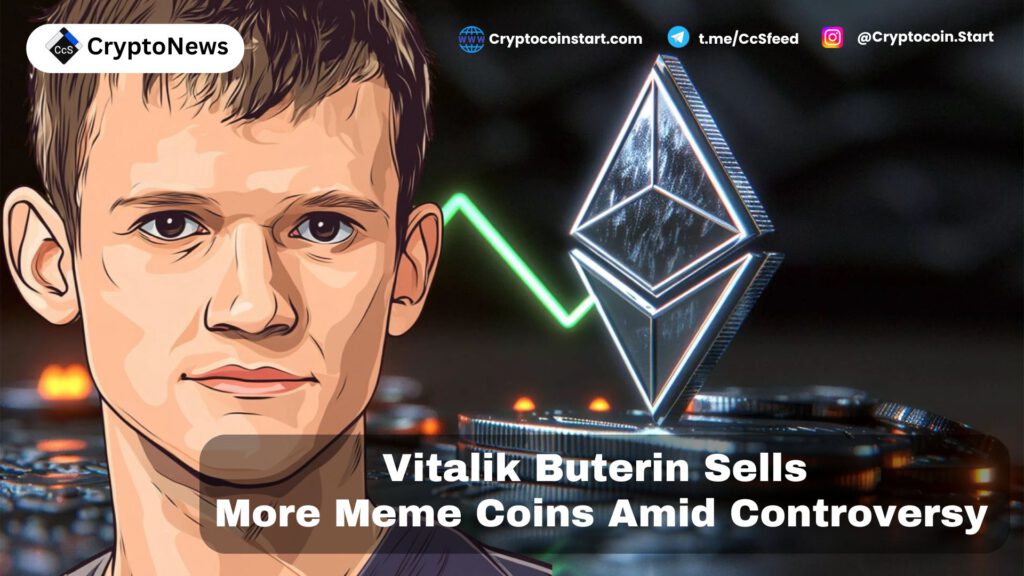
Vitalik Buterin Sells Meme Coins: Why This Sparks Debate in the Ethereum Community
Vitalik Buterin, co-founder of Ethereum, recently sold various meme coins, earning around 257.1 ETH, equivalent to $636,000. According to blockchain data from Lookonchain, the tokens were unsolicited gifts from various meme coin projects. This decision aligns with Buterin’s longstanding policy to sell or donate unsolicited tokens, yet it has reignited discussions around the risks and potential dangers of meme coins within the cryptocurrency community.
Meme Coins Sold in Bulk: What the Data Shows
Buterin’s recent transactions included a significant variety of meme tokens:
- 330,000 MSTR: Sold for 114.1 ETH ($282,000)
- 14 million POPCAT: Sold for 74.99 ETH ($186,000)
- 14 billion ITO: Sold for 36.55 ETH ($90,000)
- 1.05 million ETH6900: Sold for 15.37 ETH ($38,000)
- 50.53 billion SATO: Sold for 11.34 ETH ($28,000)
- 10 billion Milo: Sold for 4.77 ETH ($12,000)
The collective sale has garnered significant attention due to the total value and the ongoing debate surrounding the potential dangers posed by meme coins, particularly for unsuspecting retail investors.
Buterin’s Longstanding Policy on Unsolicited Tokens
Vitalik Buterin has a well-known policy of selling or donating unsolicited tokens. This practice aligns with his cautious stance on meme coins and his preference to avoid direct or indirect endorsements of projects he hasn’t personally vetted. Despite his consistent actions, some crypto community members argue that even unintentional recognition by prominent figures like Buterin can influence the market.
Recently, Buterin acknowledged two meme coin projects—EBULL and MOODENG—for their charitable contributions. EBULL and MOODENG donated a percentage of their tokens to charity, with MOODENG focused on funding anti-airborne disease research. However, this recognition led to criticism from some investors who feared that such acknowledgments could lend legitimacy to projects with unclear transparency or safety.
Community Reactions: Debates on Meme Coins’ Influence
The Ethereum community is divided over Buterin’s sale of meme coins. While some support his decision to distance himself from unsolicited tokens, others worry about the unintended effects on the market. Below are some of the major viewpoints expressed:
- Risks of Inflated Value: Some investors caution that Buterin’s involvement—even if unintended—could cause spikes in the value of certain meme coins, leading to price volatility.
- Market Manipulation Concerns: Critics argue that meme coin creators might exploit attention from notable figures, making it easier for insiders to profit at the expense of retail investors.
- Impact on Investor Confidence: Crypto analysts highlight that high-profile sales of meme coins can lead to reduced trust in speculative assets, especially those with little tangible utility.
Among those who voiced concerns, crypto personality Rug Muncher highlighted the risks for retail investors, particularly in cases where sudden market exposure benefits insiders. He emphasized the importance of transparency and urged influential figures in crypto to thoroughly vet projects before lending any endorsement, explicit or not.
Potential Risks of Meme Coins for Investors
Meme coins have become popular for their viral appeal and speculative nature. While some meme coins offer unique features or charitable angles, others pose potential risks due to limited transparency and speculative volatility. Key risks for meme coin investors include:
- Lack of Transparency: Some meme coins lack transparent development teams, which raises concerns about their legitimacy.
- High Volatility: Meme coins often experience significant price fluctuations, making them riskier for long-term investments.
- Pump and Dump Schemes: The sudden increase in value following celebrity or influencer recognition can result in a pump-and-dump cycle where early investors profit at the expense of newcomers.
Given these risks, experts in the community suggest that investors exercise caution and research thoroughly before investing in meme coins, particularly when considering coins that gain sudden popularity due to media coverage or high-profile associations.
Understanding Buterin’s Approach to Meme Coins
While Buterin has expressed concern about meme coins, he has not directly condemned them. His approach focuses on distancing himself from unsolicited projects while contributing to the larger Ethereum ecosystem. By selling or donating unsolicited tokens, Buterin hopes to avoid giving unintended credibility to these tokens.
Despite his neutral stance, Buterin’s acknowledgment of charitable initiatives in the meme coin space has raised questions. Some see this as a sign that projects with a charitable angle could be beneficial, while others worry it may attract investors to projects without sufficient due diligence.
What This Means for the Future of Meme Coins
The meme coin phenomenon is likely to persist, and Buterin’s latest sale illustrates the complexities surrounding high-profile figures and unsolicited tokens. For the cryptocurrency ecosystem, it’s a reminder of the risks associated with speculative tokens and the importance of transparency.
As the crypto market continues to grow, industry leaders may need to establish clearer guidelines for unsolicited tokens and endorsements. For now, community members and retail investors are advised to exercise caution, conduct their own research, and make informed decisions.
Conclusion: A Cautionary Tale for Investors
Vitalik Buterin’s recent sale of meme coins, though not a new practice, has reignited debates around the risks and ethics of meme coins in the crypto industry. His actions underscore the importance of responsible investing, transparency, and caution in a market that remains highly speculative and prone to sudden price changes.
For investors, this serves as a timely reminder: while the allure of meme coins may be strong, due diligence and caution are essential. As meme coins continue to evolve, investors must stay informed and make choices based on well-researched data and a clear understanding of the risks involved.

